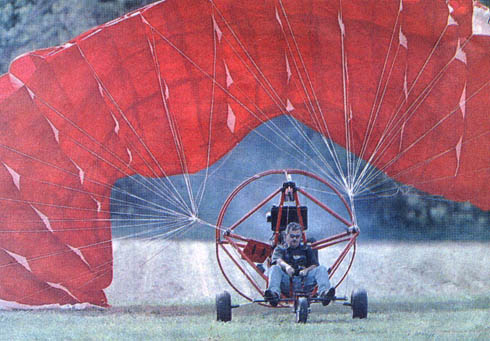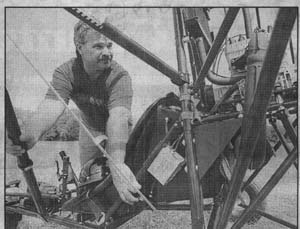|
Manatua resident finds a different way to fly  By EILEEN HOLLIDAY Staff Writer
While most dads spend their weekends sitting in front of the television watching sports or playing golf, Steve Schanne is flying a powered parachute around Mantua Township. Steve Schanne, also known as the "Parachute Guy," flies his powered parachute every Sunday, weather permitting, from an airfield next to his house. I can fly anywhere from 500 feet to the clouds," said Schanne, a Manatua Township resident who started powered parachuting about a year ago. "I can fly around for about three hours on a tank of gas. The fastest you can go is about 30 miles per hour, so it really gives you a chance to see the landscape." Claimed by its manufacturers to be the safest way to fly, the powered
parachute was originally developed and flown at the University of Notre
Dame in the 1960s and early 1970s.
A powered parachute aircraft costs approximately $13,000, including the storage trailer in which the aircraft is kept and transported. When powered parachuting, a person can fly two ways. There are two-seaters that allow two people to fly together, or a person can fly solo. When flying solo, the major powered parachuting companies recommend lessons. "I took lessons in Maryland on how to fly and maintain the machine. Safety is the most important thing," Said Schanne, as he checked the aircraft carefully before getting ready for take-off. "It is a risk sport. However, the more people that fly the less risks there are." The Federal Aviation Administration has specific rules and regulations for people flying this ultralight aircraft to follow to ensure the safety of all pilots, such as no flying at night or over cities. Powered parachuters can only fly when the winds are about 10 miles per hour. The aircraft has three flight controls, flies at a constant speed of 30 mph, and doesn't require a large runway. A pilot cannot stall, loop, roll, or dive when powered parachuting in proper safe conditions. In the event that the engine quits, the pilot will simply parachute back to the ground. Preparation for flight takes less than 10 minutes, and when the flight
is over, the parachute goes back into the parachute bag." I've had speed
boats and Harley Davidsons, but powered parachuting blows all that stuff
away," said Schanne. "Man has always wanted to fly."
|
